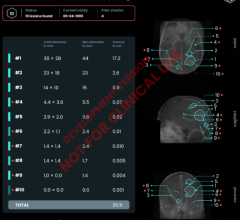
January 23, 2012 — In treatments of the first handful of patients with lung or liver tumors, Riverside and University of Virginia Radiosurgery Center in Newport News, Va., clinicians have demonstrated the benefit that Elekta's Symmetry 4-D image guidance technology provides for patients whose tumors move with their breathing. Symmetry essentially yields a more distinct picture of the tumor, without the blurring associated with breathing motion.
By having a clearer picture of the tumor position and its motion, physicians have been able to improve the targeting of tumors, thereby avoiding having to treat a larger margin of healthy tissue around the lesion. A Symmetry scan is acquired just before treatment to ensure that the patient is correctly positioned, and to visualize tumor movement.
"Symmetry scans give us clearer information about the movement of the tumor, allowing us to increase the safety of treating our patients by decreasing the dose to healthy tissues, while hopefully providing a better clinical outcome," according to Riverside medical physicist Kelly Spencer.
Tumor Motion in Sharper Focus
Before they began using the Symmetry feature in Elekta's XVI package of image-guided radiation therapy (IGRT) tools, Riverside clinicians were using sophisticated XVI 3-D cone beam computed tomography (CBCT) VolumeView CBCT imaging technology integrated with their Elekta Synergy S to image tumors. These pre-treatment scans provide physicians with added confidence in the margins that they have planned. Although seeing a target with IGRT technology such as VolumeView has been a key clinical improvement, the motion still created a blur that encompassed the tumor's range of motion.
"For our current protocol, we would create an ITV [internal target volume] to cover the blur we see on the VolumeView," Spencer said. "We began using Symmetry on a couple of patients with lower lung lesions near the diaphragm where we would expect tumor motion to be an issue. We were actually quite mesmerized by the images Symmetry provided. We could clearly see the actual motion of the delineated tumor with respect to the patient's breathing."
The same Symmetry benefit applied to a recent patient with a liver tumor situated near the diaphragm. In this case, clinicians inferred tumor motion by observing the movement of the liver with the patient's breathing.
"We wanted to use Symmetry to see how the superior border of the liver moved, and what we observed was that it did not move simply superior to inferior – there was almost a rolling pattern to the liver motion," Spencer said. "We knew that the liver didn't necessarily move symmetrically on CBCT scans, but it was harder to appreciate due to motion artifact. This movement probably varies between patients, so that is an excellent reason to use Symmetry to evaluate this motion on a case-by-case basis."
The extent of tumor motion as depicted in a Symmetry scan helps clinicians confirm that the margins around the tumor that they applied during the planning phase are as small as possible, thereby protecting healthy uninvolved tissues.
"For example, The Radiation Therapy Oncology Group SBRT Lung protocol criterion is 1 cm margins superior and inferior on the gross tumor volume," he noted. "With Symmetr,y we can potentially reduce the standard margins and thereby decrease the dose to the uninvolved lung tissues."
Accounting for tumor motion is especially important for patients with lung tumors, as Riverside's protocol calls for beam delivery while the patient is breathing freely.
"Many of our lung cancer patients are older; they often have chronic obstructive pulmonary disease or emphysema, so their shortness of breath and erratic breathing pattern makes them unsuited for breath hold treatments or any sort of gating," Spencer said.
He added that eight out of 10 patients with lung tumors could benefit from a Symmetry scan.
"We are very excited about our future with Symmetry," he said. "We expected to be able to see a clearer picture of tumor motion, but we hadn't appreciated how well we would see the motion in all three dimensions. It hasn't been just superior to inferior tumor motion; Symmetry shows how a tumor can move anterior to posterior or left to right. In that respect, Symmetry has really exceeded our initial expectations."
For more information: www.elekta.com


 December 11, 2025
December 11, 2025 









